How To Draw Leather Texture Jeepers Creepers Weapons
Fundamentals:
- Cylinder: Curved Surface
- Cube (flat)
- Brawl
Advanced:
- Cartoon boring, worn metallic
-
- Creating a non-shiny metal surface
- Adding rust
- Let's Practise: Fantasy Helmet
- Change your metal type with a gradient map!
-
- What is a gradient map?
- Changing the colour of the medallions
Fundamentals: Drawing the basic shapes
Allow's start by painting metallic onto a simple shape. The examples in this tutorial are created with Clip Studio Paint and Photoshop. The steps and basic functions used can exist repeated in about drawing software.
1. Cylinder: Curved Surface
Curved surfaces, like those found on a cylinder, are the most likely to prove the characteristics of metallic and theeasiest shape to paint a metallic surface onto. Even uncomplicated painting methods such as cel-shading can be used to evoke metallic effects, so nosotros'll start by reviewing this relatively simple painting method first.
Start, paint the curved surface with the base colour of the metal. For this example, I imagined steel, so I used grayness. Make dissever layers for both the side and the tiptop, and then it's easier to paint shadows and highlights afterward on.
In the epitome below, the color of the top has been changed to red to make viewing each of the sides easier.
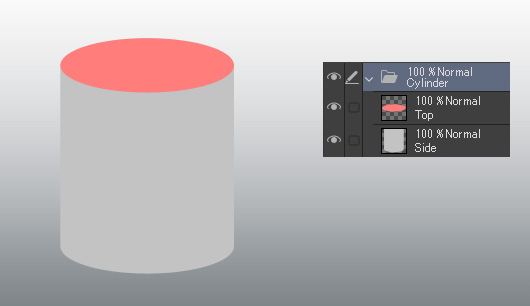
Let's paint the sides at present.
Create a new layer to use for the first layer of shadows and use a somewhat darker colour than the base colour to the sides of the cylinder, every bit in the image below. Prune the layer to the base layer and then that the painted shadows do not protrude by the painting on the base layer. Make sure your lines are parallel to the sides of the cylinder. If information technology is tilted, tilt the shadows accordingly. In this case, the light source is on the upper left side.
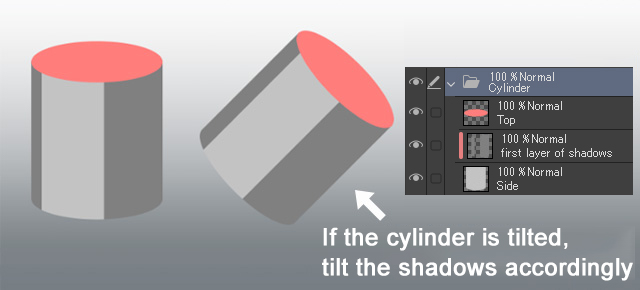
Next, create a 2nd shadow layer and paint some other shadow with a darker color, as in the image beneath.
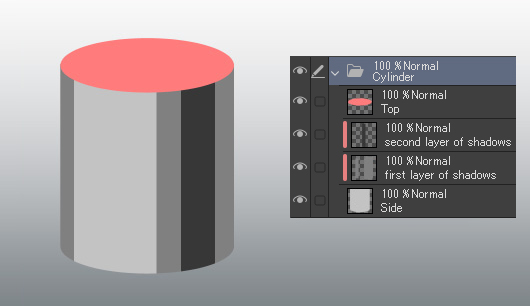
Next, create a highlight layer and paint a highlight in white from the direction of the light source. Also, pigment highlights on the edges of both sides in addition to the highlight from the direct light source. These represent ambient reflection from the surroundings.
As there is now a distinction between the top and the side surfaces of the cylinder, nosotros changed the summit from red to the same gray that was used for the base color of the metal.
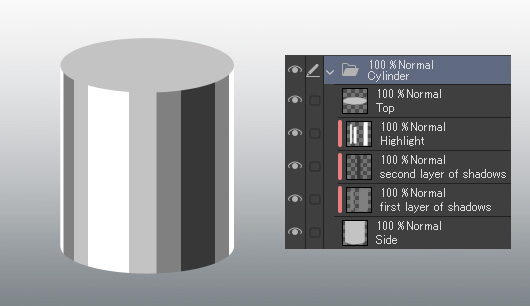
For the final step, add a blurred highlight to get in look more metallic.
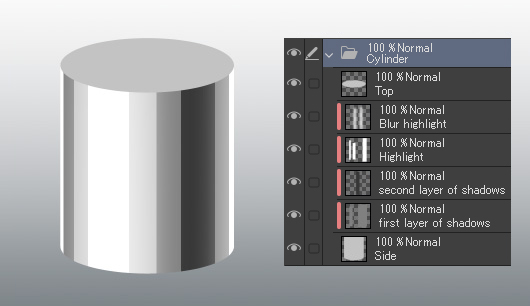
With that, the cel-shading painting procedure of a curved surface is now complete. Next, nosotros volition review how to paint a flat surface for the elevation apartment office of the cylinder.
The higher up painting method is simple but constructive in creating a metallic appearance on a curved surface . Although processes for painting metallic in anime sometimes differ due to the use of software such as AfterEffects, this is a similar end to how metal armor and other items on anime characters look. That being said, this method is still a bit bare-bones, so permit's have a wait at a slightly more elaborate metal painting method for the top office of the cylinder.
To achieve that game illustration feeling, we should blur the shadows and highlights. If nosotros blur them farther away from the light source, rather than blurring them overall, it will brand the surface appear even more metallic.
For an oil painting effect, use a tool similar to the watercolor castor that leaves thick brushstrokes behind in the artwork.
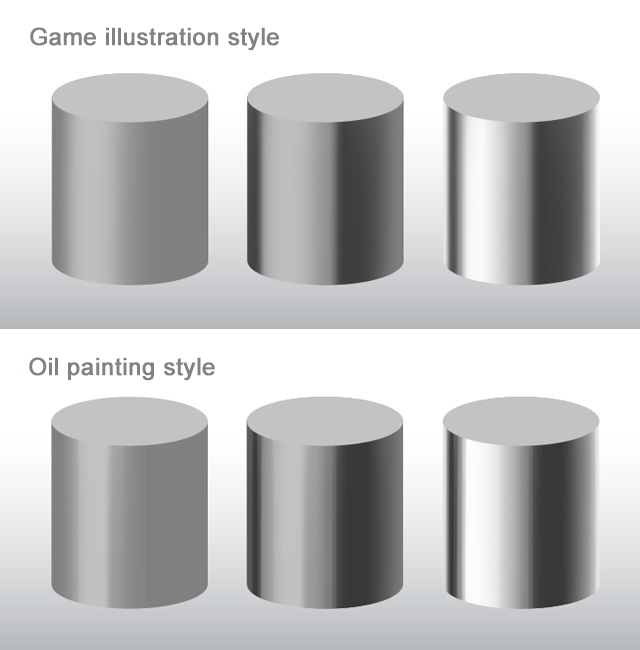
So, the main points when drawing a curved surface like a cylinder can exist summarized equally follows:
- Paint shadows and highlights parallel to the sides of the cylinder
- Add together highlights to the edges to show the ambience light from the surroundings
- As you paint in shadows further abroad from the chief light source, blur them for maximum effect
We can accept this method and use it on objects other than cylinders such equally rings, bracelets, bondage, etc. Let's utilize what we have learned so far to other shapes such as rings and bracelets. After all, these are actually simply brusque cylindrical objects.
Paint the shadows and highlights on the inner and outer face up of the ring parallel to its sides.
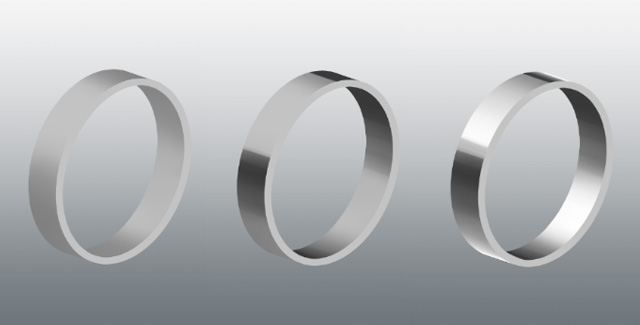
Like a cylinder, chains are likewise bent and curved. However, it is different than the round surface of the ring then light too hits information technology differently. Pay close attending to the direction of the shadows and highlights.
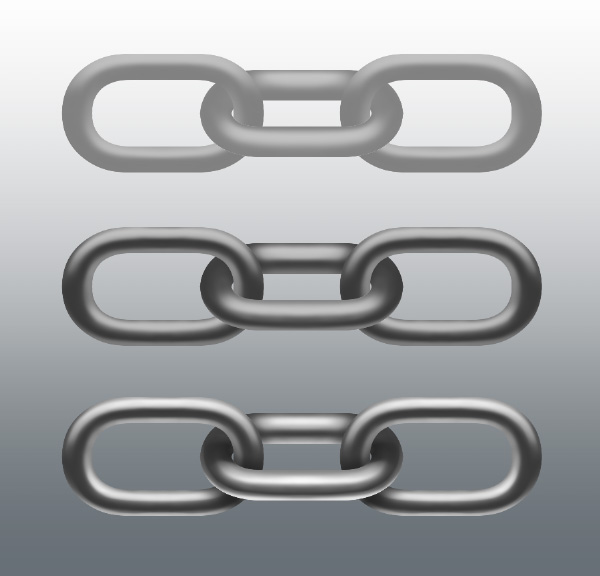
2. Cube (flat)
Next, permit's paint a cube. Previously, we looked at painting a curved surface; now, we will look at how to pigment a metallic outcome on a apartment plane. First, simply similar with the curved surface, paint the base gray. Again, to brand it easier to paint shadows and highlights on each side, the meridian side is on a separate layer. In the effigy below, the colour of the top has been inverse to red for ease of understanding.
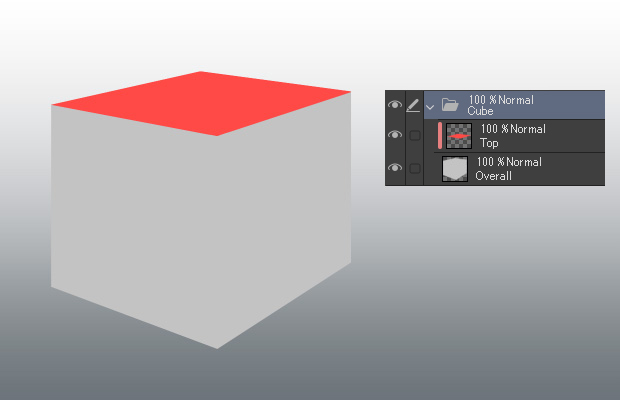
Create a shadow layer for each face of the cube and paint in the shadows similar in the paradigm below. Setting a layer mask for each face makes it easier to pigment them. For cubes, painting them with an anime style is unexpectedly tricky, and so nosotros will paint them in a video game-like style instead. The calorie-free source is on the upper left, like with the cylinder.
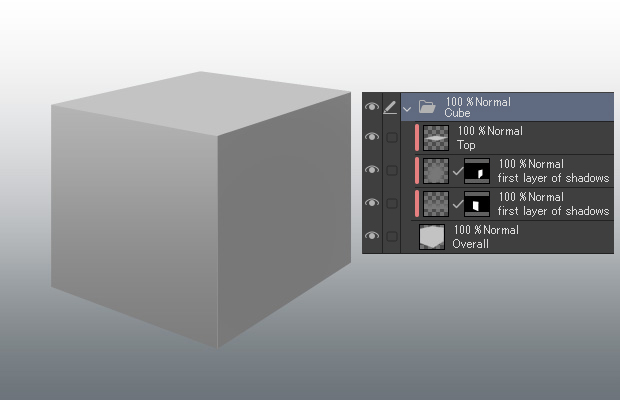
Next, paint in a darker shadow. Remember not to make the summit and left sides besides nighttime because the light source is on the top left. Then, create a second shadow layer for the right side of the cube and shade it in with an even darker color. Leave the lesser of the correct side slightly brighter to correspond the reflection coming up from the ground.
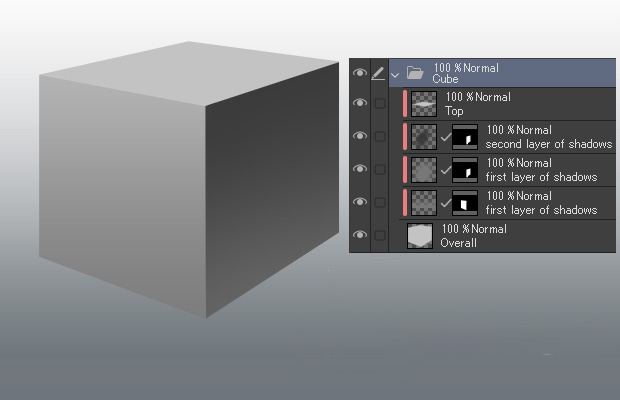
Add strong highlights to the edges and corners of the surface. This helps achieve a metal look.
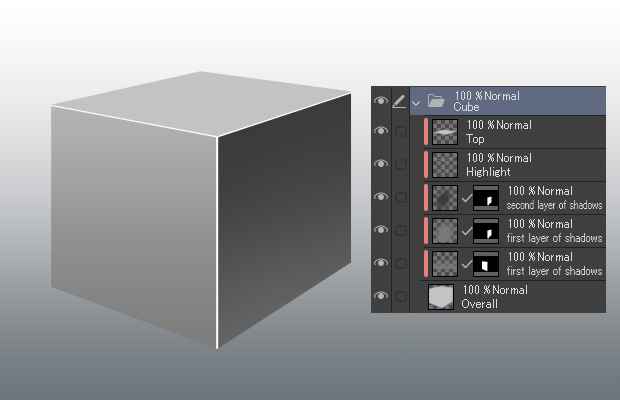
Finally, add some soft, blurred highlights, every bit in the image below. Once more, describe highlights that are reflections from the surroundings. In this case, paint them upward from the footing. This is a useful technique for expressing a metallic surface. Increasing contrast betwixt adjacent surfaces besides gives it a more metallic advent.
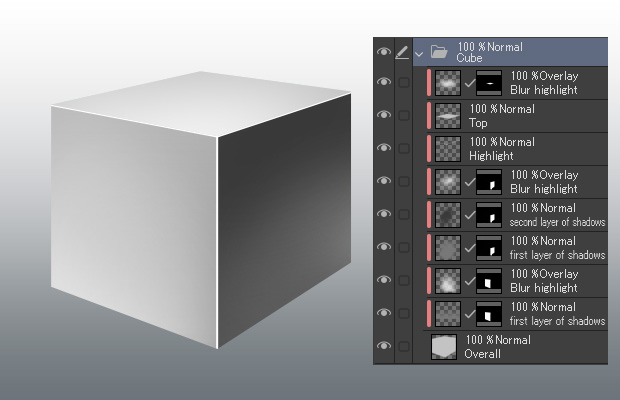
Our cube is at present consummate. When using this method on a apartment surface, it can often end up looking plastic instead of metallic or just altogether unconvincing. The same applies when painting cubes with an anime-style. So, allow's push button the painting a little farther to solidify the metallic cease on our cube.
Metal reflects its surroundings like a mirror. Past drawing in reflections, you can express this quality of the metallic. Reflections are challenging to describe. How sharply the surrounding objects are reflected depends on the processing of the metal. If you draw them in too precipitous, it volition look similar the object is floating over the cube rather than being a reflection.
If what is being reflected isn't an essential office of the illustration, it's improve to draw in simple reflections instead.
For planes, information technology's best to add together these kinds of reflections to the plane that has faint highlights and shadows along its surface. Here, but the highlights are added. Furthermore, reflecting surrounding objects also ways reflecting the color of those objects. A useful technique is to lightly reflect those colors off of the surface closest to them.
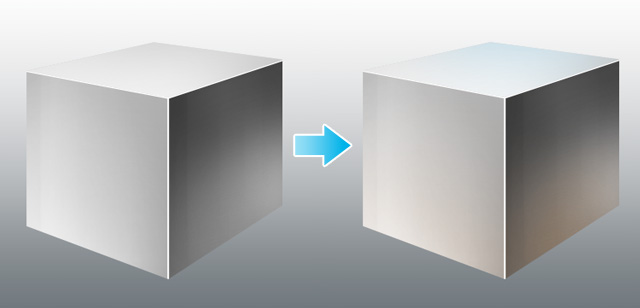
To sum upward cartoon planes:
- Strong highlights on the edges and corners of the surface
- Increasing contrast of lite and dark between adjacent surfaces also gives it a stronger metallic appearance
- Create reflections of surrounding objects past lightly adding shadow on the surface
- Add colour to express the reflection of color from surrounding objects
This is the completed upshot of applying this last function to a cylinder or ring.
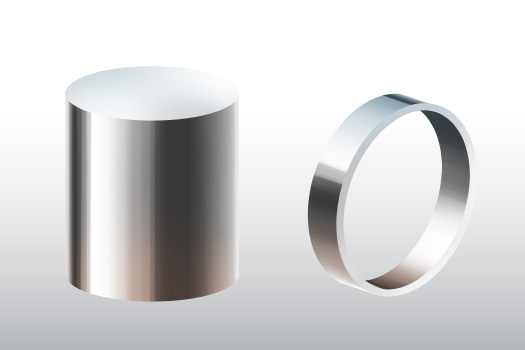
3. Ball
Finally, allow's draw a sphere. It is quite challenging to properly express the reflections of a sphere, so for this tutorial, we will just paint a uncomplicated version instead. Moreover, the sphere doesn't have multiple sides similar a cylinder or a cube, which further simplifies the process.
First, paint the sphere normally. Then, add a subtle highlight on the bottom of the sphere to give it a more than metal advent.
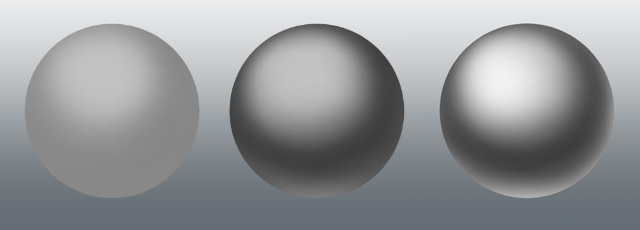
For a simple sphere, you can stop hither. Y'all can accept it a footstep farther by adding the reflection of the surrounding colors as we did with the cube.
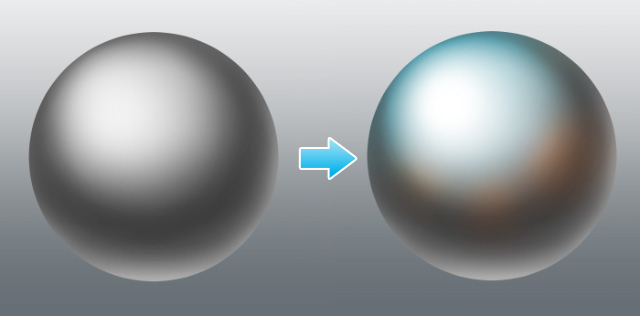
To further enhance the reflection of light, either hide your outset layer of shadows or forgo it from the get-go, then at that place is an fifty-fifty sharper contrast between calorie-free and dark, making the sphere look even more metallic.
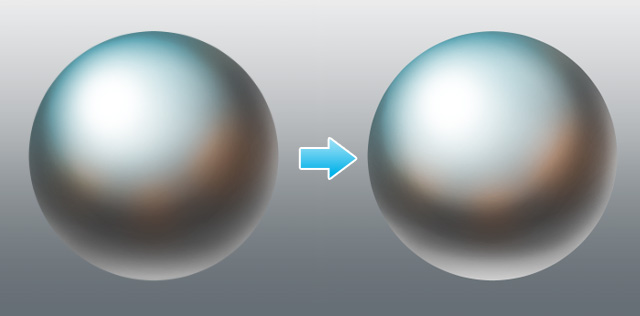
You lot tin can even go a footstep further andadd a highlight from another low-cal source.
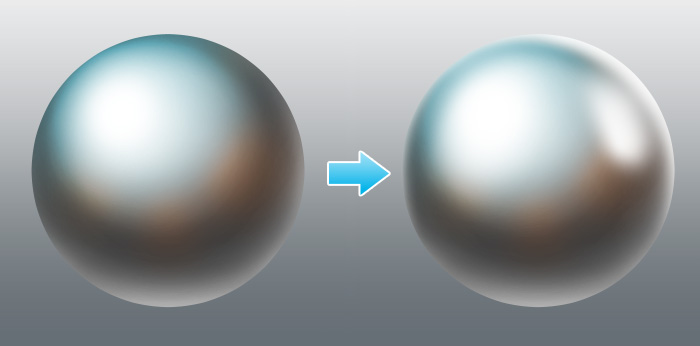
Then the points when drawing a sphere are as follows.
- Add a subtle highlight on the bottom of the sphere to give it a more metallic appearance
- Express its metallic appearance by reflecting the color of surrounding objects
- Sharpen the dissimilarity betwixt calorie-free and night and add more light sources
Cartoon tiresome, worn metal
And then far, we've only looked at how to draw smoothen, cogitating metallic surfaces, so now, let'south take a look at how to draw a dull metal surface.
Creating a not-shiny metal surface
Metal that is not shiny can be easily expressed past using a texture included in your drawing software.
1. Calculation a texture image
First, let's place a texture onto the canvas.
●For Photoshop
Select Window > Pattern to open the Pattern panel.
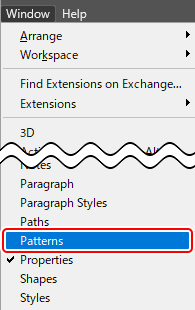
Click the menu of the Pattern console and select Legacy Patterns and More than to load additional pattern images.
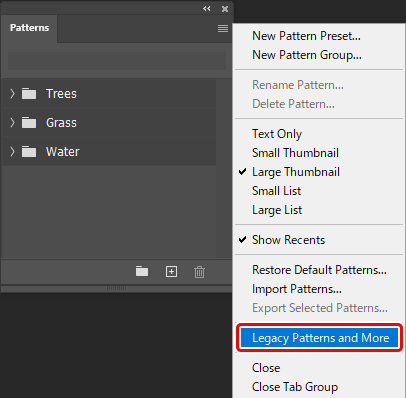
Create a new layer and fill up information technology with white. Select Layer Mode > Pattern Overlay > Matte Texture to use information technology to the layer. Then, open Layer Style > Pattern Overlay > Pattern and select the Texture group from Legacy Patterns and More group > Legacy Patterns group we just loaded.
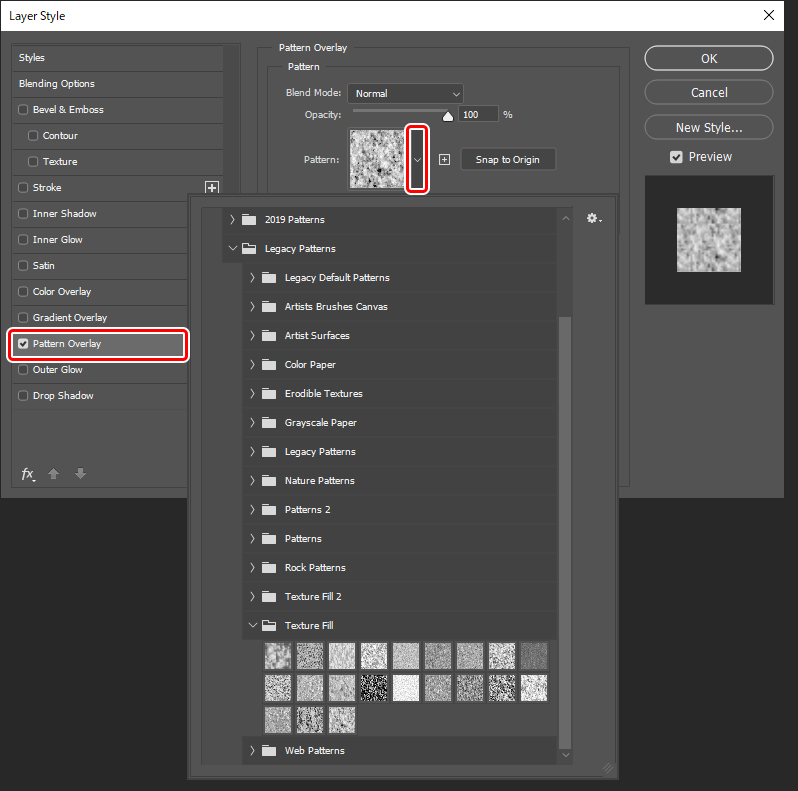
The Texture set is a set that contains texture patterns for rocks and trees. The pattern was created with the settings shown beneath.
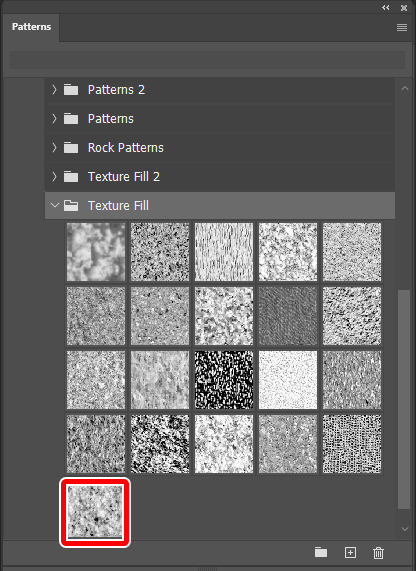
Set both the blueprint overlay blending mode and the Layer effects blending style (the layer console blending mode) to Soft low-cal.
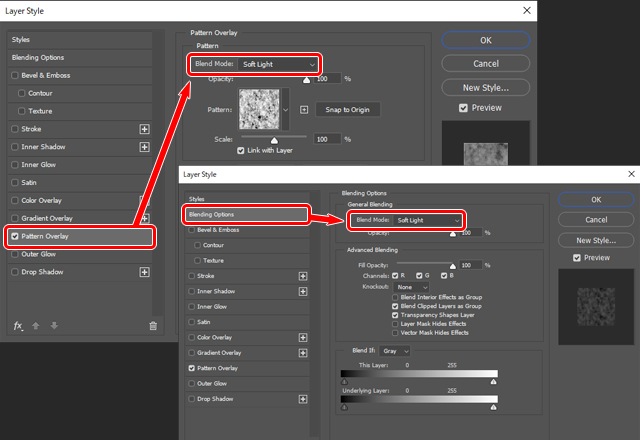
●For Clip Studio Paint
Click onTexture fromMaterial palette >Monochromatic blueprint.
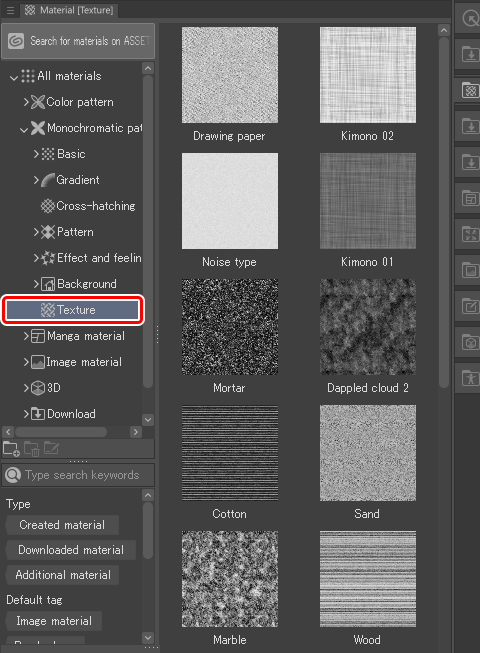
Elevate the desired texture prototype from the material palette onto the sheet and set its blending mode toSoft light. For the sake of this tutorial, I named the layer "Material texture."
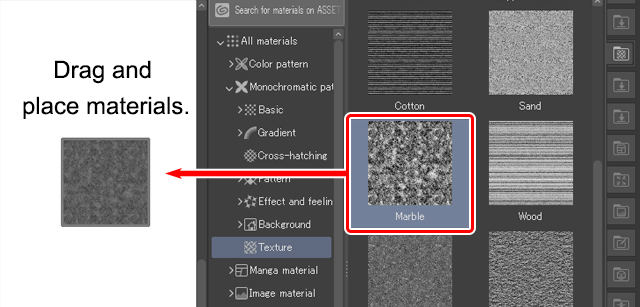
2. Clip the texture to the metal cube
From here, the process is the same for both software. Prune the "Fabric texture" layer to the layer showing the metallic cube. In the example, the texture paradigm layer is clipped to a layer binder that contains all the layers of the metal cube. Then, reduce the opacity of the fabric texture layer to about ten–30%, depending on how slow you want the metal to wait.
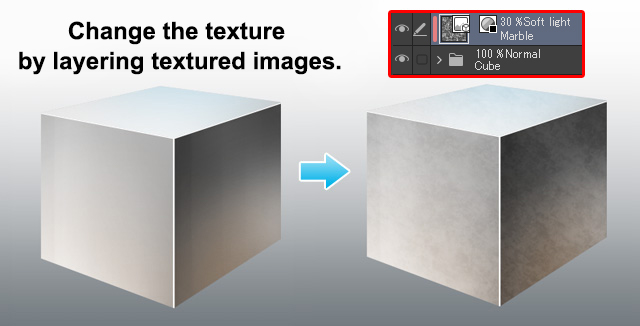
iii. Finishing touches
At this stage, the metal looks dull, but depending on the texture used, the blueprint may wait too noticeable or too flat. In that case, add together a layer mask to the "Cloth texture" layer, and erase whatsoever unnecessary parts with a castor that has a blurred border. Finally, slightly reduce the opacity of the metal highlights. This reduces its shine. That completes our elementary method of rendering a metal surface with a deadening finish.
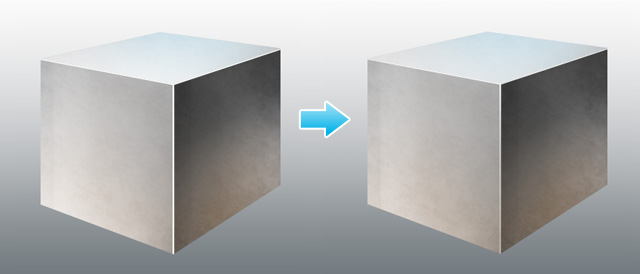
Calculation rust
Metal rust is created past adding several different layers together. Let'due south add rust to a cube equally an example.
First, add a layer for drawing rust on top of the binder that contains the cube layers. We'll call it Cherry-red rust. Side by side, yous tin can clip to the cube folder, but we want to create a clipping layer on the Cherry-red rust layer itself, and so instead, we will add a layer mask in the shape of the cube in the folder. And so, draw some rust on the Red rust layer and set the layer's blending mode to Linear burn to match the shade of the shadows on the cube. Depending on the hue of the metal, yous may find that another blending mode suits the epitome better.
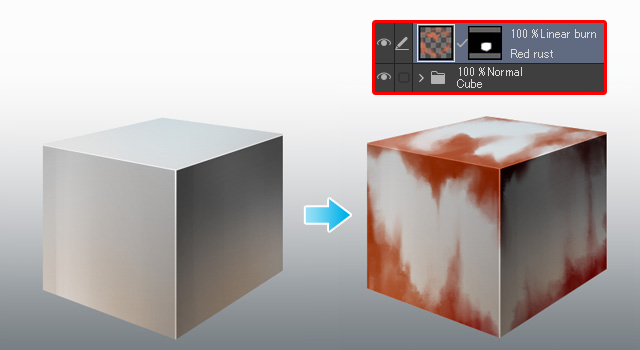
Next, create a layer and clip it to the "Cherry rust" layer below and add some darker areas to the rust.
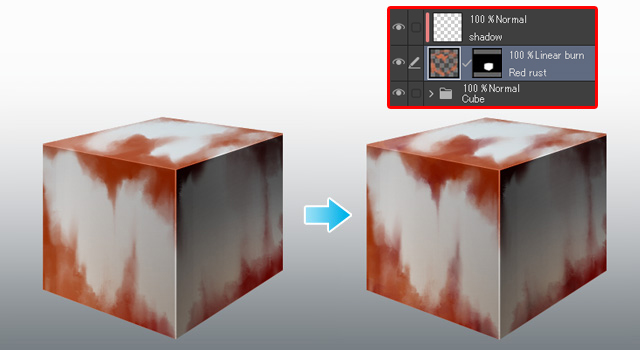
Finally, add together a texture image to create the fine irregularities caused by erosion. I used the Oil pigment texture from Clip Studio Pigment. Modify the blending mode of the texture toSoft light and lower the opacity. If the texture pattern is also noticeable, add a layer mask and adjust as needed. Our rusted metal cube is at present consummate!
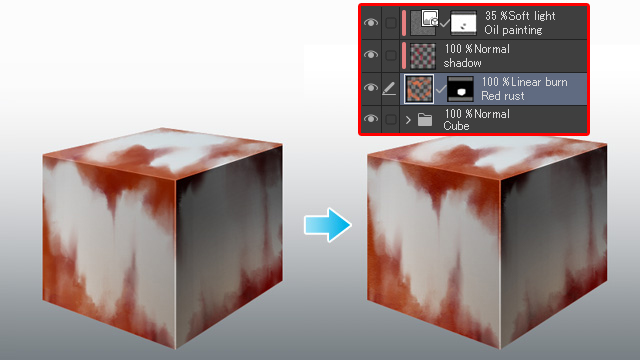
Let's Practice: Fantasy Helmet
So, do you have the basics of painting metal down nevertheless? Fifty-fifty with access to tutorials, it tin be challenging to put these methods into practice. So let's employ these basic shapes to draw something complex.
I've fatigued a medieval fantasy helmet that combines uncomplicated shapes. First, I split each part into separate base of operations layers. We prepared the below epitome as a reference to show how we divided our base layers, but there is no problem if you do this stride on your own.
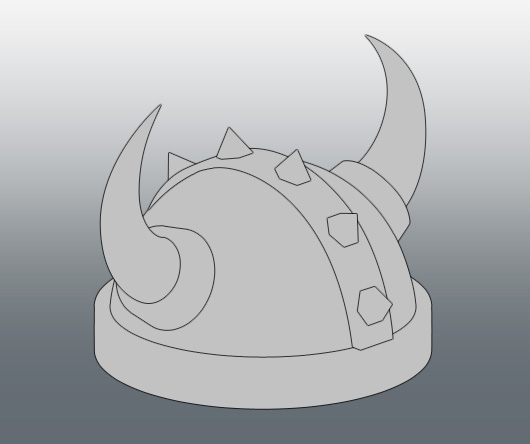
Information technology may not look like information technology at starting time, simply this complex shape is made upwardly of a combination of simple shapes we discussed earlier in the tutorial.
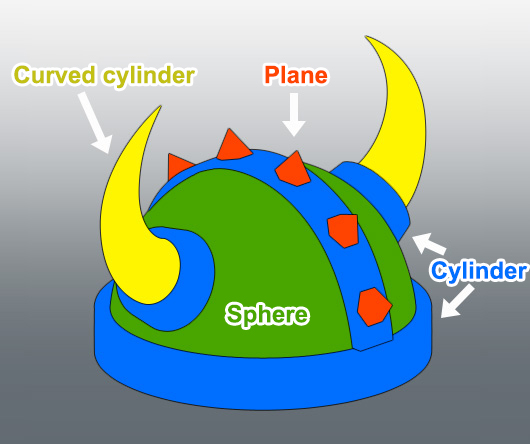
Start, let's paint the part that covers the caput, which occupies most of the helmet. You can apply the sphere shape here.
For this example, in that location are ii light sources, ane on the upper left towards the back and one on the correct. Keeping a bones idea of the low-cal sources in listen, nosotros paint in the shadows.
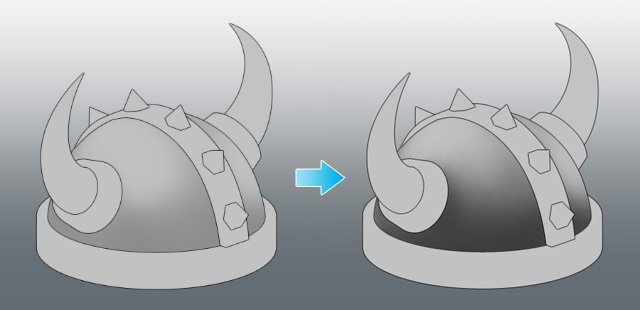
With those finished, we and then add together highlights and some sharper shadows created past lite sources, and nosotros can move onto the adjacent part.
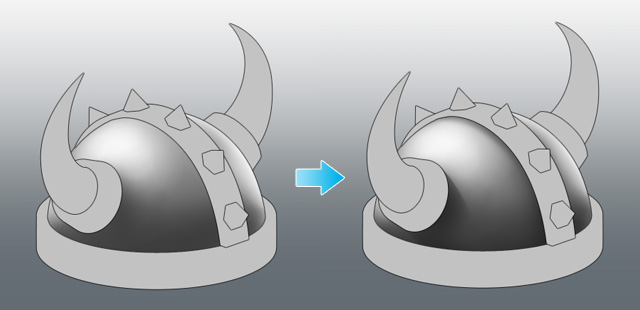
Next, let's paint the places around the base of the horns and the rim of the helmet where the cylinder painting method tin be applied. Every bit before, keep in listen where the light sources are while painting. Withal, thinking about it as well much can cause unbalanced low-cal and shadow, which lowers the image'south three-dimensional appearance, and so just loosely continue it in mind when thinking about how the shadows and highlights are cast.
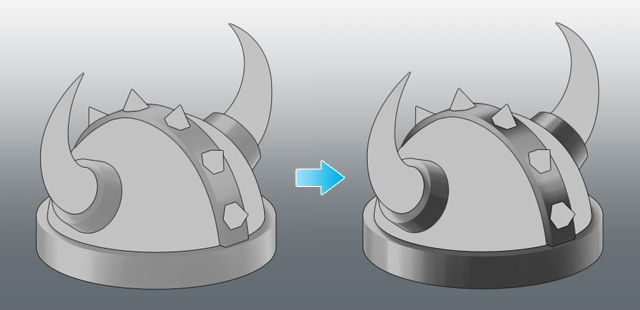
Add highlights after finishing the shadows. For these parts, they volition look ameliorate with a abrupt, articulate contrast betwixt low-cal and shadow.
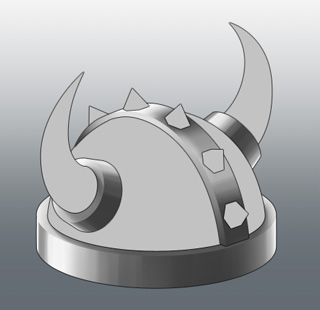
Permit'southward movement onto the horns. Despite the curve, they tin likewise be painted using the cylinder method.
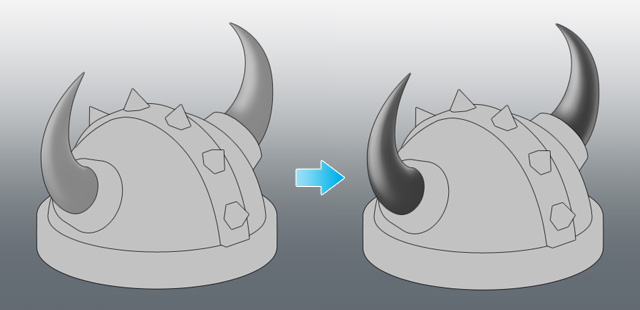
There are some challenging areas to create shadow as the shape is curved and tapered, but once they are finished, the highlights are then added, and the horns are now complete.
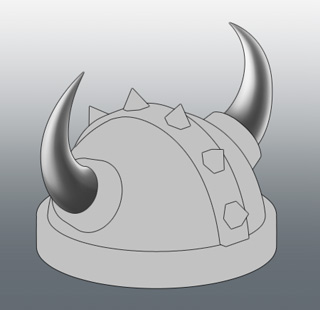
Finally, let's pigment the spikes using the apartment airplane painting method. Employ two separate planes of shadow that have a divergence in contrast.
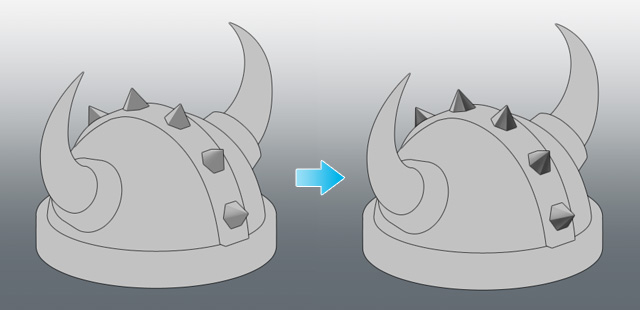
Then add highlights to complete each spike.
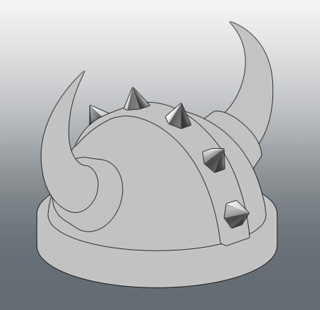
At present, look at the image as a whole and make whatsoever adjustments needed. I felt that the spikes needed some more than brightness, so I added more than highlights and shadows, equally in the paradigm beneath.
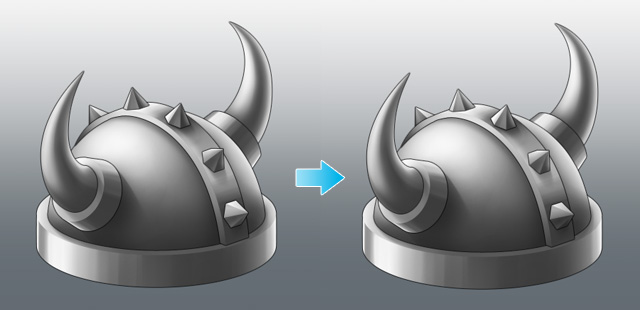
The helmet is now consummate.
By the style, you can remove the line-piece of work, and your image will wait like the epitome below. I think that beginners volition desire to focus on the line cartoon, but I recommend removing them considering illustrations without lines aid make the prototype feel even more three-dimensional.
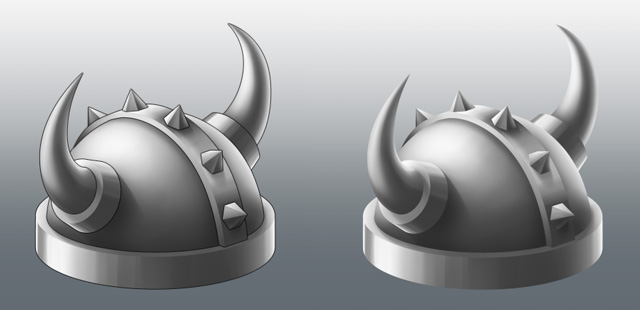
Bonus: Change your metal type with a gradient map!
Finally, as a little actress, I want to talk about a function called a gradient map that can be used in both Photoshop and Clip Studio Paint. This function allows you to hands create gold, silver, and bronze medallions from a black and white illustration.
What is a gradient map?
A gradient map is a special kind of layer thatassigns a color according to brightness.
From here, I volition explain the process of using a gradient map using Photoshop. Let's start with a simple example. Create a new sheet in Photoshop and fill up it with a black and white slope.
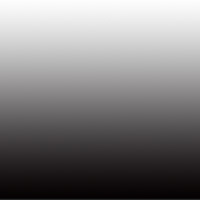
Adjacent, we'll create a gradient map. SelectLayer carte>New Correction Layer >Slope Map to create a gradient map layer.
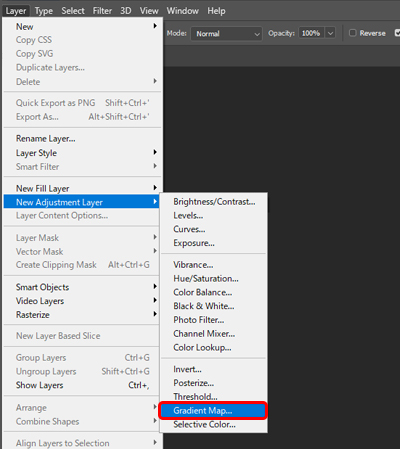
The layer comes with an attached mask that hides half the layer, which shows us how the effect works.
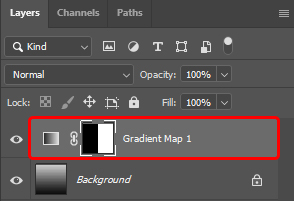
We will gear up up the gradation map from theAttributes panel. Select the gradient map layer and click the gradient displayed in theAttributes panel to prove theSlope editor.
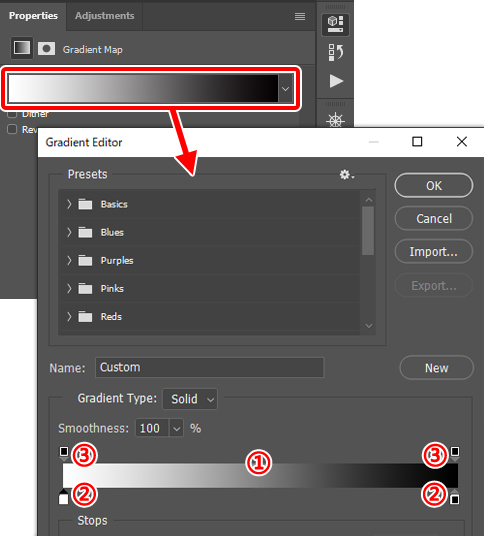
In the Gradient Editor is the color bar (i) containing the colors of the set gradient. (2) contains nodes that fix the gradient colour, and (3) includes nodes that set the opacity of the color. Click i of the nodes in (two) and click (4) [Color] to display the Colour Picker, where you tin select the color to set for the node.
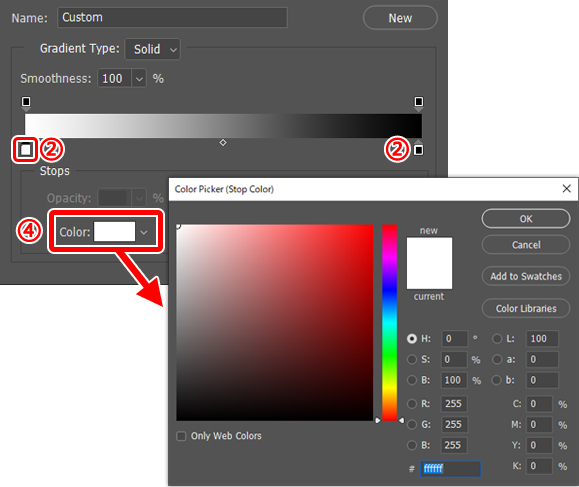
For now, let'southward set up the left node (two) to red and the right (2) node to blue. You can see in the image beneath that this changes each part of the gradient on the canvas to the corresponding colors.
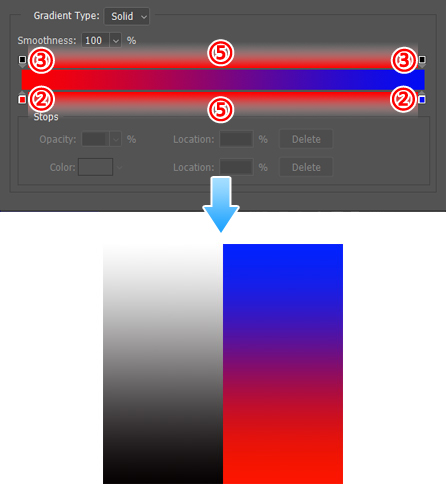
Every bit you may have noticed with the gradient settings, the left-paw colour (carmine) is replacing the dark colors, and the right-mitt color (blue) is replacing the light colors. The (2) and (3) nodes tin be added by clicking on the area of (5) and can be moved by dragging. Yous can also erase the node by dragging information technology exterior the (5) area. For example, y'all can change the paradigm by calculation another node on (2) and setting its color to greenish.
By irresolute the colour of the lighter part of the gradation to greenish, the light gray function of the black and white image has now also inverse.
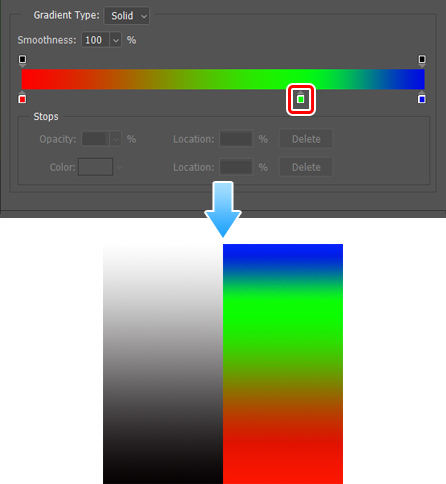
Changing the color of the medallions
Now, allow'southward modify the black and white medallions to gold and silverish statuary using a gradation map. First, prepare a medallion fatigued in black and white.
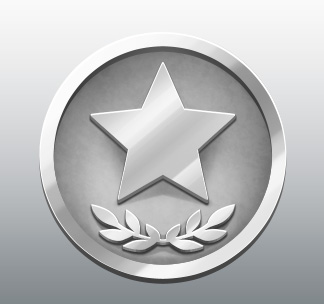
From hither, we will use the gradient map. Create a gradient map layer and prune it to the folder that contains all the layers of the medallions.
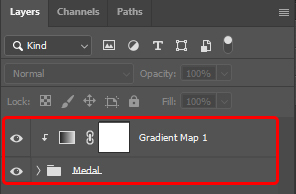
Later that, set the gradient colors and create gilded, silver, and copper colors. The gradient for each colour was created with the settings shown below. Depending on the black and white of the medallions and the exact positions of the node, gradient results may vary but, the beneath image is notwithstanding a skillful reference guide for the colors.

Aureate gradient
(i) R:51 1000:42 B:17 / position: 20%
(ii) R:153 G:126 B:fifty / position: fifty%
(3) R:255 G:230 B:130 / position: 85%
(4) R:255 Grand:249 B:227 / position 100%

Silver gradient
(1) R:48 G:49 B:51 / position: 20%
(2) R:121 Chiliad:124 B:128 / position: l%
(iii) R:210 G:213 B:217 / position: 85%
(4) R:255 G:255 B255 / position: 100%

Copper gradient
(1) R:51 Thou:40 B:twenty / position: xx%
(two) R:128 1000:99 B:51 / position: 50%
(iii) R:217 Thou:169 B:87 / position: 85%
(4) R:255 G:218 B:153 / position: 100%
The event of applying this gradation map setting to each of the iii black and white medallions is every bit shown beneath. This allowed us to change the color of the medallions to gold, argent, and bronze medallions without repainting.
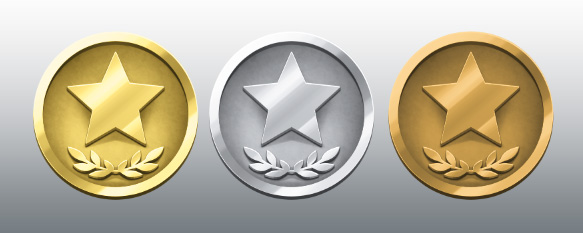
The color settings of the gradient map tin can also be used equally normal gradients. Saving your favorite gradient settings may make the slope map fifty-fifty more useful. Too, many gradient color palettes are published every bit free materials. Even so, their usage may differ, then be sure to check whatsoever data posted along with them.
Author & Creative person: Sugiyama Yuzuki (すぎやま ゆずき) Freelance Illustrator
I mainly create objects and items for smartphone games, such as buildings. I also create manga and games every bit a part of the fanzine group "orangish girl."
Twitter: twitter.com/yuzuki
Source: https://www.clipstudio.net/how-to-draw/archives/159970
Posted by: mayerwhishis1967.blogspot.com


0 Response to "How To Draw Leather Texture Jeepers Creepers Weapons"
Post a Comment